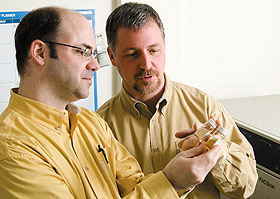  |
| HOME | THIS ISSUE | CALENDAR | GRANTS | BACK ISSUES | < BACK | NEXT > |
Scientists study health implications of products using nanosilverby Colin Poitras & Timothy Stobierski, CLAS ‘11 - February 17, 2009
|
||||
| The growing commercial use of nano particles and nano-sized devices just billionths of a meter in length has raised concerns about the potential health and environmental implications of such products. Recently, Christopher Perkins, laboratory director at the Center for Environmental Sciences and Engineering, and Sylvain De Guise, an associate professor of pathobiology in the College of Agriculture and Natural Resources, discovered that popular disinfectants using nanosilver particles could affect some people’s health. Germicidal properties The ability of nanosilver particles to fend off germs is widely known. But it is what happens when these particles break free and enter the body that concerned UConn researchers the most. Through recent laboratory testing, Perkins and De Guise discovered that the ingestion and inhalation of minute amounts of these silver particles can affect human cells, and may diminish the functioning of the immune system in some individuals. Extremely small concentrations of nanosilver particles, around 10 nanometers in diameter, were shown to slow down the secretion of cytokines. Cytokines are a category of signaling molecules that are used extensively in cellular communication. Such cytokine suppression, says Perkins, indicates “your immune system is not operating at peak capacity.” Larger silver particles exhibited almost no effect on cytokines, regardless of their concentrations. “The major finding is that we are seeing effects at concentrations much lower than those usually studied in conventional toxicology,” says De Guise, the primary investigator for the project. “This dismisses the conventional wisdom in toxicology that ‘dilution is the solution.’” Immune system response
The cells that had been exposed to nanosilver demonstrated a dramatically increased rate of consumption compared to those that had not been exposed. While this might appear to be good news, it is hard to tell, Perkins says Immune system cells must be able to clear pathogens from the body. But if they become overly aggressive, they can waste energy and risk accidentally attacking healthy cells. The researchers also measured the abilities of cells encountering nanosilver to release bursts of free radicals – chemically reactive molecular fragments meant to damage or kill invading germs or sick cells that need disposal. Cells exposed to the smaller nanosilver particles showed increased bursts. That also could be cause for concern, Perkins says. “You’ve got all of these free radicals that have to go somewhere,” Perkins says. “And they’re pretty nonspecific in what they target, which means they could kill healthy cells as well as bacteria or other pathogens.” So far, the researchers’ findings have been limited to test tubes in the laboratory. They stress that the potential impact of nanonsilver particles on human beings will only be understood through additional testing. In some cases, the disinfectant capabilities of nanosilver particles may outweigh the immune system risk in individuals who are very sick. But the immune system effects found in the lab, they say, are of enough concern to warrant further study. “One of the next steps is to assess the concentrations of nanosilver in people’s tissues following natural exposure to consumer products,” says De Guise, “and to assess whether or not they approach those at which we demonstrated toxicity in tissue cultures.” |
| ADVANCE HOME UCONN HOME |

